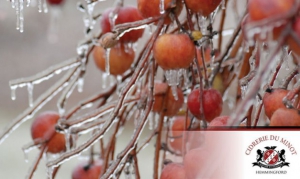
Apples that hang on the tree well into winter aren’t crucial to making ice cider, but they lend an air of authenticity similar to that surrounding ice wine.
In an interview with Good Fruit Grower, Brigitte Lavigne, an assistant at Cidrerie du Minot, said there are two methods for making ice cider. One is cryoconcentration, in which apples are pressed and juice is allowed to freeze outside during the cold Quebec winter. Water in the juice moves to the top as ice forms, and the high-sugar juice at the bottom is removed for fermentation.
The other, more expensive, method is cryoextraction, in which apples are left on the trees or left outside to freeze and then ground and pressed while they are frozen. Ice remains in the apple pomace, and the extracted, concentrated juice is fermented.
In either process, malic acid is also precipitated by the freezing process. Cold fermentation, which takes weeks or months, follows.
In 2005, the Quebec government created a special designation for ice cider, called cidre de glace in French, defining how it must be made. The cider must be from juice concentrated by natural cold to at least 30 degrees Brix and, after fermentation, must have residual sugar level of 130 grams per liter. The final product must be between 7 and 13 percent alcohol.
The high residual sugars in the finished product make them best served cold at the end of a meal, with cheeses or creamy desserts. Ice cider tastes much like rich, homemade apple pie.
The producer must be the grower, and all the preparation must take place at the production site. No concentration of sugars by any method other than natural cold is allowed, nor may any fruit other than apples be used. No alcohol may be added, nor may any flavorings or colorings.
The first ice cider was made by Christian Barthomeuf, a colorful person who fits the artisan craftsman image, farming with horses and bringing in frozen apples to crush in his wooden press. He shared the process with neighbors around Frelighsburg, who now produce the sweet, amber-colored, near-syrupy dessert drink. Since the year 2000, he has been the cider maker at Domaine Pinnacle, one of the largest producers of ice cider.
The movement to ice cider has caught on in Vermont, just south of Quebec.
Special apples
The emergence of ice cider influenced the apple breeding program led by Dr. Shahrokh Khanizadeh at Agriculture and Agri-Food Canada at St-Jean-sur-Richeleau. In 2005, he released an apple called Eden that he described as aromatic, sweet, juicy, firm, and crisp that had the unusual feature of hanging on the trees into winter.
That breeding program was terminated this year, but trees from the program are in the test orchard at Cidrerie du Minot, along with a similar new release, Diva, and the varieties Galarina and Primevere. Galarina is from France and does not drop. Diva is resistant to apple scab and winter hardy, ripening late, three weeks after McIntosh. It, too, hangs on the tree.
These varieties are not essential to ice cider production. Most ice ciders are made by picking the apples in the fall and storing them, later taking them or just their juice outside to freeze. By choosing apple varieties that don’t drop, the apples can be left on the trees and picked frozen for squeezing, more in the purist grape ice wine method. In that best format, ice cider is made after three consecutive nights with temperatures below -10 degrees Celsius (14°F.)
Other growers in the region say that any sweet apple works well. But it takes 12 pounds of apples to make a bottle—unless you get the small, 200-milliliter size bottle, which is fast becoming popular for ice cider.

Leave A Comment